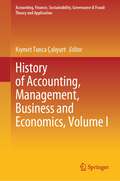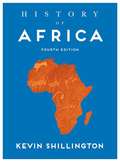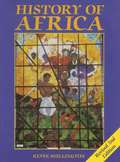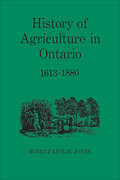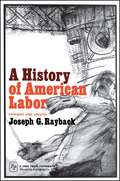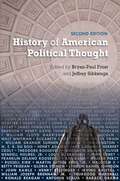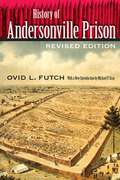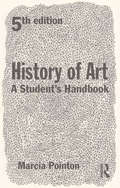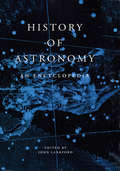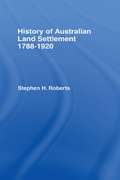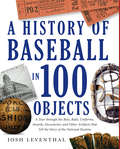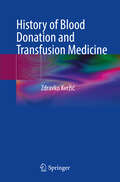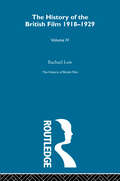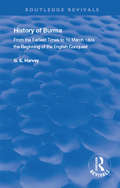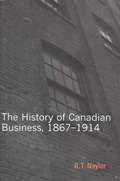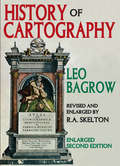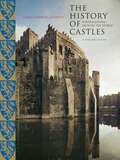- Table View
- List View
History of Accounting, Management, Business and Economics, Volume I (Accounting, Finance, Sustainability, Governance & Fraud: Theory and Application)
by Kıymet Tunca ÇalıyurtThis book brings together works written by academics from all over the world on all aspects of business history: accounting history, management history, economic history, audit history, tax history, financial history, and professional history. Writing, transferring and archiving historical knowledge allows future generations to take lessons from the past and make more informed decisions regardless of whether it is in politics, society, or business. "Historization" can also be seen as the first step of institutionalization for private and governmental companies, institutions, professionals, and states. Institutionally managed historical activities, decisions, and results are accepted as a very important reference about the company for decision-makers and stakeholders. Additionally, "historization" is used in the development and promotion of professions. Historization of professions such as certified public accountants, external auditors, internal auditors, economists, tax experts, certified fraud examiners, and managers nationally and internationally has the potential to educate and motivate new entrants to such roles. As such, this book is a valuable read for business historians, professionals in the field, academics, and students of business.
History of Africa
by Kevin ShillingtonThis fourth edition of this best-selling core history textbook offers a richly illustrated, single volume, narrative introduction to African history, from a hugely respected authority in the field. The market-leading range of illustrated material from prior editions is now further improved, featuring not only additional and redrawn maps and a refreshed selection of photographs, but the addition of full colour to make these even more instructive, evocative and attractive. Already hugely popular on introductory African History courses, the book has been widely praised for its engaging and readable style, and is unrivalled in scope, both geographically and chronologically – while many competitors limit themselves to certain regions or eras, Shillington chronicles the entire continent, from prehistory right up to the present day. For this new edition, both content and layout have been thoroughly refreshed and restructured to make this wealth of material easily navigable and even more appealing to students unfamiliar with the subject.
History of Africa (Revised 2nd edition)
by Kevin ShillingtonNow fully revised and updated, this classic text offers an illustrated and critical narrative introduction to the history of Africa from earliest times to the present. Beginning with the evolution of mankind itself, the book traces the history of Africa through the millennia of the ancient world to the centuries of medieval and modern Africa.
History of Agriculture in Ontario 1613-1880
by Robert Jones Fred LandonThis comprehensive history of Ontario's agricultural development, first published in 1946, is a classic of scholarship and readability. It will appeal not only to agriculturalists and historians but also to anyone interested in life in early Ontario.
History of Air-to-Air Refuelling
by Richard M. TannerThis is a unique account of the development and operational use of air-to-air flight refuelling since its early beginnings in the USA and the UK to the equipment that is in use today. The author draws upon his life-long career as senior design engineer with the successful British company In-Flight Refuelling who were responsible for the development of the hose and drogue technique now preferred by many of the world's air forces. The story begins in the early 1920s when the art of air refuelling was part of the Barn Storming record-breaking attempts that were popular in the USA. It continues into the late thirties when successful experiments were made. Amazingly, the Royal Air Force were not interested in pursuing this great technical advantage during World War II and it was the USAAF who requested the British invention to experiment with on their B–17s and B-24s. The Korean War saw extended use of operational air-to-air refuelling for the first time and now the 'tanker fleet' is an essential unit in major air-forces around the world.
History of American Education Primer
by David BoersDepicting the evolution of American educational history from 1630 to the present, the book highlights how ideological managers have shaped society.
History of American Labor
by Joseph G. RaybackA compact and comprehensive chronicle of where labor has been and where it is today.
History of American Political Thought, Second Edition
by Bryan-Paul Frost;Jeffrey SikkengaRevised and updated, this long-awaited second edition provides a comprehensive introduction to what the most thoughtful Americans have said about the American experience from the colonial period to the present. The book examines the political thought of the most important American statesmen, activists, and writers across era and ideologies, helping another generation of students, scholars, and citizens to understand more fully the meaning of America. <P> This new second edition of the book includes chapters on several additional historical figures, including Walt Whitman, Lyndon Baines Johnson, and Ronald Reagan, as well as a new chapter on Barack Obama, who was not prominent in public life when the first edition was published. Significant revisions and additions have also been made to many of the original chapters, most notably on Antonin Scalia, which now updates his full legacy, increasing the breadth and depth of the collection.
History of Andersonville Prison
by Ovid L. FutchIn February 1864, five hundred Union prisoners of war arrived at the Confederate stockade at Anderson Station, Georgia. Andersonville, as it was later known, would become legendary for its brutality and mistreatment, with the highest mortality rate--over 30 percent--of any Civil War prison.Fourteen months later, 32,000 men were imprisoned there. Most of the prisoners suffered greatly because of poor organization, meager supplies, the Federal government’s refusal to exchange prisoners, and the cruelty of men supporting a government engaged in a losing battle for survival.Who was responsible for allowing so much squalor, mismanagement, and waste at Andersonville? Looking for an answer, Ovid Futch cuts through charges and countercharges that have made the camp a subject of bitter controversy. He examines diaries and firsthand accounts of prisoners, guards, and officers, and both Confederate and Federal government records (including the transcript of the trial of Capt. Henry Wirz, the alleged "fiend of Andersonville"). First published in 1968, this groundbreaking volume has never gone out of print.
History of Art: A Student's Handbook
by Marcia PointonThis fully revised edition of the History of Art: A Student's Handbook introduces students to the kinds of practices, challenges, questions and writings they will encounter in studying the history of art. Marcia Pointon conveys the excitement of Art History as a multi-faceted discipline addressing all aspects of the study of media, communication and representation. She describes and analyses different methods and approaches to the discipline, explaining their history and their effects on the day-to-day learning process. She also discusses the relationship of Art History to related disciplines including film, literature, design history and anthropology. The fifth edition of this classic text includes: * information on why Art History is important and relevant in today's world guidance on choosing a degree course case studies of careers pursued by Art History graduates advice on study skills and reading methods a bibliography and further reading detailed up to date advice on electronic resources and links to essential websites History of Art covers academic, training and vocational aspects of Art History, providing a wealth of information on the characteristics of courses available and on the relationship between Art History and the world of museums and heritage.
History of Astronomy: An Encyclopedia (Garland Encyclopedias in the History of Science #1)
by John LankfordThis Encyclopedia traces the history of the oldest science from the ancient world to the space age in over 300 entries by leading experts.
History of Australian Land Settlement
by S.H. RobertsFirst published in 1969. Routledge is an imprint of Taylor & Francis, an informa company.
History of Baseball in 100 Objects
by Josh LeventhalThe only book of its kind to tell the history of baseball, from its inception to the present day, through 100 key objects that represent the major milestones, evolutionary events, and larger-than-life personalities that make up the game A History of Baseball in 100 Objects is a visual and historical record of the game as told through essential documents, letters, photographs, equipment, memorabilia, food and drink, merchandise and media items, and relics of popular culture, each of which represents the history and evolution of the game. Among these objects are the original ordinance banning baseball in Pittsfield, Massachusetts, in 1791 (the earliest known reference to the game in America); the "By-laws and Rules of the Knickerbocker Base Ball Club," 1845 (the first codified rules of the game); Fred Thayer's catcher's mask from the 1870s (the first use of this equipment in the game); a scorecard from the 1903 World Series (the first World Series); Grantland Rice's typewriter (the role of sportswriters in making baseball the national pastime); Babe Ruth's bat, circa 1927 (the emergence of the long ball); Pittsburgh Crawford's team bus, 1935 (the Negro Leagues); Jackie Robinson's Montreal Royals uniform, 1946 (the breaking of the color barrier); a ticket stub from the 1951 Giants-Dodgers playoff game and Bobby Thomson's "Shot Heard 'Round The World" (one of baseball's iconic moments); Sandy Koufax's Cy Young Award, 1963 (the era of dominant pitchers); a "Reggie!" candy bar, 1978 (the modern player as media star); Rickey Henderson's shoes, 1982 (baseball's all-time-greatest base stealer); the original architect's drawing for Oriole Park at Camden Yards (the ballpark renaissance of the 1990s); and Barry Bond's record-breaking bat (the age of Performance Enhancing Drugs). A full-page photograph of the object is accompanied by lively text that describes the historical significance of the object and its connection to baseball's history, as well as additional stories and information about that particular period in the history of the game.
History of Blood Donation and Transfusion Medicine
by Zdravko KvržićThis book offers a global overview of the history of blood donation using evidence-based research to provide accurate information on the beginnings of blood donation and transfusion medicine, developed as the result of numerous trials and successes throughout history. It leads the reader step-by-step through time, to discover how people perceived blood, and how they managed to develop new ways of treating various unfortunate conditions that shattered a person’s healthy life. This book also presents new technical discoveries that have advanced through the present day and explains how, in cases of deadly diseases, safety procedures for blood examination have been made mandatory. The conditions that led to the contamination of thousands of patients by HIV and hepatitis C around the world are explained, and the debate between voluntary and paid systems is covered as well. This book is a unique resource beneficial for everyday practice, as it encourages the reader to develop advanced practices for better and safer work with blood donors and in transfusion medicine; It gives a sense of humanitarian devotion to the deed of giving a part of yourself to save others’ lives in danger because of trauma, disease, etc., and it shares different stories of blood donors, to help patients get over their fear of donating blood. It is useful for nurses, doctors, students, blood donors, historians, and other experts!
History of Britain and Ireland: The Definitive Visual Guide (DK Definitive Visual Histories)
by DKDiscover the pivotal political, military, and cultural events that shaped British and Irish history, from Stone Age Britain to the present day, in this revised and updated ebook.Combining over 700 photographs, maps, and artworks with accessible text, the History of Britain and Ireland is an invaluable resource for families, students, and anyone seeking to learn more about the fascinating story of the England, Scotland, Wales, and Ireland. Spanning six distinct periods of British and Irish history, this ebook is the best way to find out how Britain transformed with the Norman rule, fought two world wars in the 20th century, and faced new economic challenges in the 21st century.DK's visual guide places key figures - from Alfred the Great to Winston Churchill - and major events - from Roman invasion to the Battle of Britain - in their wider context, making it easier than ever before to learn how they influenced Britain and Ireland's development through the age of empire into the modern era.
History of Britain and Ireland: The Definitive Visual Guide, New Edition (DK Definitive Visual Histories)
by DKFrom ancient bloody battles and colonial conquests to the Industrial Revolution and Beatlemania, this visual guide leads you through major moments in British and Irish history.Discover the pivotal political, military, and cultural events that shaped British and Irish history, from the Stone Age to the present day. Combining over 700 photographs, maps, and illustrations with accessible text, History of Britain and Ireland is an invaluable resource for anyone seeking to learn more about the British Isles. Spanning six distinct periods of English, Welsh, Scottish, and Irish history, the book tells you how Britain transformed with Norman rule, fought two World Wars in the 20th century, and finally came to terms with a new status in a fast-changing economy.This comprehensive volume places key figures – from Alfred the Great to Winston Churchill – and major events – from Caesar's invasion to the Battle of the Somme – in their wider context. This makes it easier than ever before to learn how certain charismatic leaders, political factions, and specific events influenced Britain and Ireland's development through the Age of Empires and into the modern era.Beautifully illustrated, History of Britain and Ireland is sure to delight history buffs of all ages.
History of British European Airways, 1946–1972: 1946 - 1972
by Charles WoodleyBEA was formed in 1946 and took over most UK domestic and European routes under the British government's nationalisation policy. It began operations with a fleet of outdated and hopelessly uneconomic passenger aircraft that were derivatives of wartime types such as the DC-3, Avro Viking and Rapide. By the end of 1955 the airline had re-equipped with more modern types such as the jet-prop Viscount and moved into a profit for the first time. From 1960 onwards the airline introduced larger jets such as the Comet, Trident and BAC 1-11. BEA merged with the British Overseas Airways Corporation in 1974 to form British Airways.This book looks at BEA's predecessors, its formation and early operation from Croydon and Northolt and the move to the newly-opened London Heathrow. The evolving structure is explained with chapters covering engineering bases, terminals, European and domestic services, cargo services and helicopter operations. The aircraft flown are all described in detail and the book includes anecdotes from former crew and ground-staff, a full fleet list and is highly illustrated throughout.
History of British Film (Volume 4): The History of the British Film 1918 - 1929
by Rachael LowThis set is one of the cornerstones of film scholarship, and one of the most important works on twentieth century British culture. Published between 1948 and 1985, the volumes document all aspects of film making in Britain from its origins in 1896 to 1939.Rachael Low pioneered the interpretation of films in their context, arguing that to understand films it was necessary to establish their context. Her seven volumes are an object lesson in meticulous research, lucid analysis and accessible style, and have become the benchmark in film history.
History of Burma: From the Earliest Times to 10 March 1824 The Beginning of the English Conquest (Routledge Revivals)
by G. E. HarveyOriginally published in 1983, this book explores the history of Burma, including chapters on Burma before 1044, The Kingdom of Pagan and the Shan Dominion. Burma's history had been little studied until recently, until the Burma Research Socety, founded in 1910, began to collect material of all kinds, and this book may be regarded therefore as one of the first-fruits. The book presents a mass of original work and incorporates the results of research up to the date of going to press; it offers a flood of light on the still many dark places of Burmese history and constitutes distinctly a step forward in our knowledge of the subject.
History of Canadian Business
by R. T. NaylorAn unprecedented work in Canadian historiography, The History of Canadian Business, 1867-1914 has been chosen by the Social Sciences Federation of Canada as one of the twenty most outstanding works in the field in the last half of the twentieth century.
History of Canadian Business: The Banks And Finance Capital (Carleton Library Series #207)
by R.T. NaylorAn unprecedented work in Canadian historiography, The History of Canadian Business, 1867-1914 has been chosen by the Social Sciences Federation of Canada as one of the twenty most outstanding works in the field in the last half of the twentieth century.
History of Cartography: Enlarged Second Edition
by Leo BagrowThis illustrated work is intended to acquaint readers with the early maps produced in both Europe and the rest of the world, and to tell us something of their development, their makers and printers, their varieties and characteristics. The authors' chief concern is with the appearance of maps: they exclude any examination of their content, or of scientific methods of mapmaking. This book ends in the second half of the eighteenth century, when craftsmanship was superseded by specialized science and the machine. As a history of the evolution of the early map, it is a stunning work of art and science.This expanded second edition of Bagrow and Skelton's History of Cartography marks the reappearance of this seminal work after a hiatus of nearly a half century. As a reprint project undertaken many years after the book last appeared, finding suitable materials to work from proved to be no easy task. Because of the wealth of monochrome and color plates, the book could only be properly reproduced using the original materials. Ultimately the authors were able to obtain materials from the original printer Scotchprints or contact films made directly from original plates, thus allowing the work to preserve the beauty and clarity of the illustrations.Old maps, collated with other materials, help us to elucidate the course of human history. It was not until the eighteenth century, however, that maps were gradually stripped of their artistic decoration and transformed into plain, specialist sources of information based upon measurement. Maps are objects of historical, artistic, and cultural significance, and thus collecting them seems to need no justification, simply enjoyment.
History of Castles, New and Revised
by Christopher GravettThe History of Castles is the ultimate guide to the world&’s most fascinating castles and strongholds. Chapters include information on castles from France, England, Wales, Scotland, Ireland, Germany, Austria, Switzerland, the Iberian Peninsula, Italy, Scandinavia, Eastern Europe, Russia, and the Middle East. An ideal book for history enthusiasts, people planning to take a vacation near one of these castles, and for anyone who is enamored of these breathtaking buildings.

